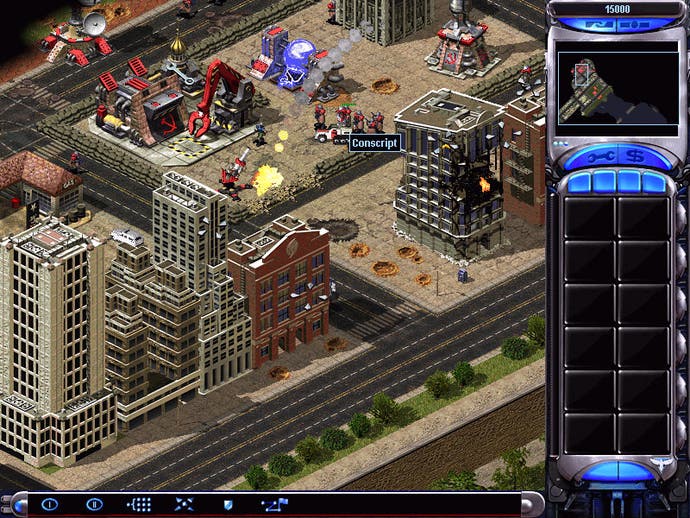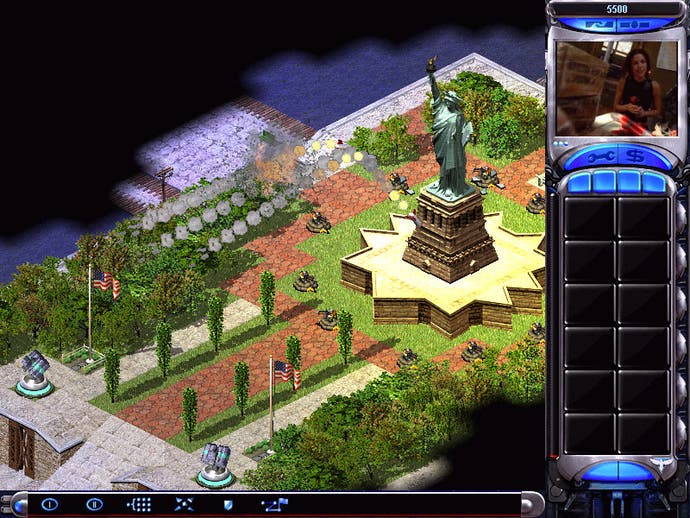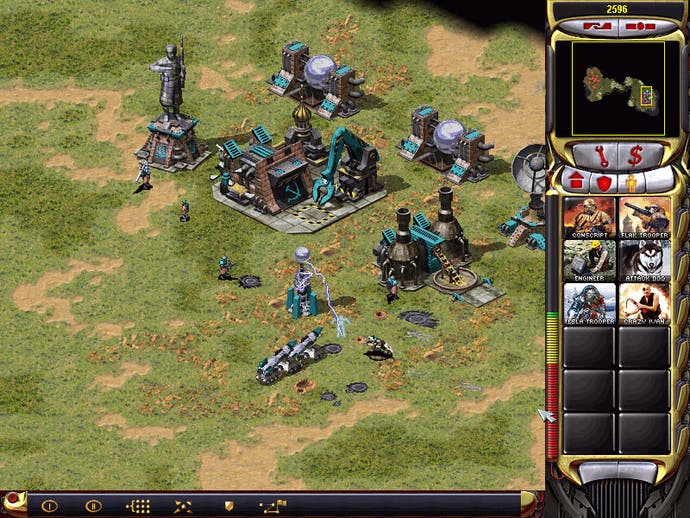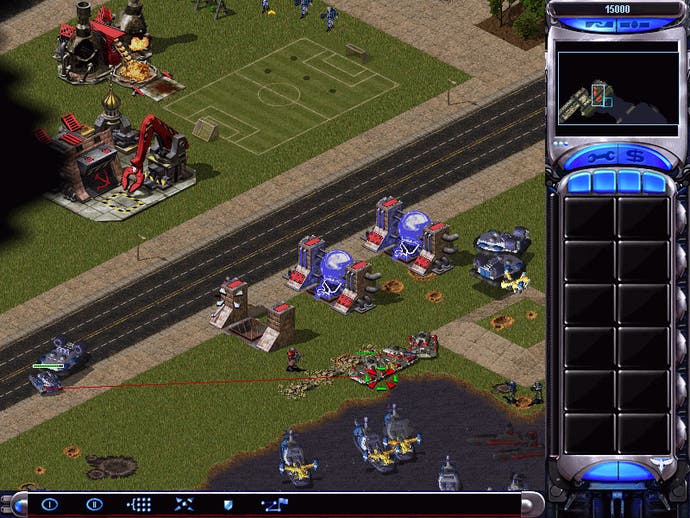Command & Conquer : Red Alert 2
Review - The Russians are coming! The Russians are coming!
Red Alert 2 is, unsurprisingly, the sequel to Westwood's highly successful real-time strategy game Red Alert, and the Tiberian Sun engine which powers the sequel gives it vastly improved graphics and network code, as well as a slicker interface to work with.

Back To Basics
The game is set in a world where Hitler was "removed" by the actions of Albert Einstein, using a device known as a Chronosphere. This prevented World War 2 from taking place, but in the original Red Alert a new conflict arose between Russia and the USA and her European allies. Now Russia is ruled by Premier Romanov, a puppet put in place by the allies to ensure that the country could never again pose a threat. But Romanov has plans of his own and, with the assistance of a powerful psychic called Yuri, he has secretly built up extensive military forces which he plans to use to invade the United States itself.
The story opens with the Russian forces landing on the shores of the USA, and there the action begins. As with the previous games there are two single player campaigns, one for each side, and both armies are available in the multiplayer mode. For anyone unfamiliar with the Command & Conquer series, or the real-time strategy genre in general, the idea is to "harvest" or collect resources (ore and gems in the case of Red Alert), which can then be used to build structures to form your base. These structures can either be defensive (such as turrets), unit-producing (such as barracks) or ancillary (such as radar installations). With the unit-producing structures you can build troops, tanks, aircraft and other forces to wage war on your enemies with.

Beautiful Battlefields
As with all the other games in the series, the story in Red Alert 2 is told through a series of FMV cutscenes. The video quality has been vastly improved though, with not only fewer codec artifacts, but also much better CG effects. The acting is still just as bad as before, although since the game seems to have its tongue firmly planted in its cheek as far as the plot goes, this is not too much of a problem - the B-movie style acting seems to fit the bill quite nicely.
One trick which was sadly under-used in Tiberian Sun is the ability to run videos in-game in the small window normally used for the radar display. Red Alert 2 uses this frequently to give updates "from the ground" during battles, which adds very nicely to the atmosphere, and makes the 16-pixel high troops seem much more real. The in-game graphics are also a big improvement, both over the first Red Alert game and also over Tiberian Sun. Whilst some of the inherent engine problems are still present (such as the tendency for small units to merge into a single blur when standing together), the models are much better designed and the overall look of the game is much brighter and more distinct than in Tiberian Sun.
Amongst the other graphical improvements are the ability to increase the resolution up to 1024x768 (which was only possible in Tiberian Sun by editing the INI files manually), and numerous small changes like an option to show icons for units hidden behind buildings. The maps have also been given a massive overhaul - there are now sprawling cities (many of which have recognizable landmarks), as well as the previously-seen icy wastelands and verdant farmland. These improvements are more than just cosmetic, however - troops can now be garrisoned in buildings, which affords them a degree of protection from enemy fire, and "tech buildings" scattered around the levels can be captured to provide benefits to their owner. For example, oil derricks provide a steady stream of income without requiring ore collectors or refineries. Just about every structure on the maps can be destroyed as well, with bonuses given in some cases for creative destruction (or rebuilding) of key facilities.
The sound is almost exactly what you would expect. The effects are spot-on, and the remarks made by the various units are both amusing and relevant. The music is a combination of new tunes and remixes of themes from the original, and it works well. It's certainly a step up from the uninspiring Tiberian Sun music...

Taking Command
The single player campaigns in Red Alert 2 are extremely well though-out and balanced. The mission objectives vary a lot from mission to mission, and whilst they are all generally along the lines of "kill everything" the methods by which you do this vary. For example, one level involves using the Eiffel Tower as a giant Tesla coil, whilst another forces you to take command of a series of scattered groups of troops and mount an offensive on multiple fronts.
The enemy AI is still not as good as it could be, but it is a vast improvement over the last game, and it can use some of the more advanced strategies (such as effective deployment of the Iron Curtain weapon to make attacking units invincible). Interestingly, there are also a small number of multiplayer campaigns which can be played by two human players against computer opponents. While these are nowhere near as well-polished as the main campaigns (feeling more like preset skirmishes than "proper" missions), they are a thoughtful inclusion and well worth playing through, as joining forces against the AI with other human players can a lot of fun.
The new units introduced in Red Alert 2 are also a varied bunch, and again Westwood demonstrate how much they have learnt about play balancing during the development of the Command & Conquer series. Each of the units serves a unique purpose, and the scissors-paper-stone relationships between them means that there is no strategy that cannot be somehow countered. My personal favorite is "Crazy Ivan", the Russian demolitions expert who can put explosives on anything. Yes, anything - buildings, vehicles, people, and even dogs and cows aren't safe! This leads to some interesting tactics, such as building a pack of dogs, attaching bombs to them, and then running them into enemy units...
Then, just to prove that they can break the rules and still get away with it, the developers introduced the "super weapons". These are roughly the same as in the other games in the series, with familiar favorites such as the nuclear missile launcher and chronosphere, joined by newcomers like a weather control device. These are all ridiculously overpowered (the weather control device can level a small base in seconds), but they are balanced by the fact they take a long time to charge (up to ten minutes in some cases), and when a player builds one every other player in the game gets a warning (and on-screen countdown to activation), as well as having the location of the device revealed to them!

Paging General Chaos
This is a brilliantly executed bit of game design, causing a mad rush as the other players all gang up on the owner of the device in order to destroy it before it can be fired. This is very much in keeping with the general spirit of the game, as it has been "balanced high" (that is, in favor of more destructive units), which results in much faster, bloodier battles.
The super-weapons frequently force the ending of a game one way or another - either the owner fires one and virtually annihilates an opponent with it, or they themselves are wiped out in the rush to avoid the devestating effects of the device. This is a massive help in preventing the long, drawn-out endgames which were commonplace in previous installments of the series.
The multiplayer component of Red Alert 2 is the focus of the game though, and rightly so. The balance of the two sides is almost spot-on, with neither the Allies nor the Russians having an overwhelming advantage in any particular scenario, unlike in the first game, where the Allies could almost inevitably win on any map with water thanks to their Cruisers, while the Russian tanks would take out any ground forces elsewhere. In addition to this, each side is broken up into a number of separate countries, such as England, France and America. Each country has its own special unit - the English get snipers, for example, whilst the French get a huge defensive cannon. This adds an extra edge to the gameplay, and gives individual players a chance to pick their favorite side.
There are lots of small multiplayer tweaks to improve gameplay, such as the ability to set beacons which can be seen by your allies to co-ordinate your attacks, and the option to build structures on to your allies' bases. There are a number of different multiplayer modes, including the "World Domination" campaign system seen in Tiberian Sun, and the ability to use Westwood's other on-line matching services. The only real disappointments with the multiplayer are that the game still has the odd connection problem (and still uses the outdated IPX protocol for LAN games), and that it is impossible for more than one player to play online at the same time through a shared Internet connection - a bit of a downside in days where shared cable and ADSL connections are becoming commonplace.

Conclusion
Red Alert 2 is definitely the best game to date in the Command & Conquer series, and Westwood have shown considerable merit in learning from (and correcting) the mistakes of their previous games. The single player campaigns are great fun, and multiplayer has been very well balanced and improved so that most of the rough edges have been smoothed out, resulting in a game that is simply great fun to play.
There are still a few areas that could do with polishing (mainly the network code), but apart from that the biggest criticism I can think of is that the cardboard inset used for the second CD in the DVD-style box feels cheap and likely to break after a few months use...







